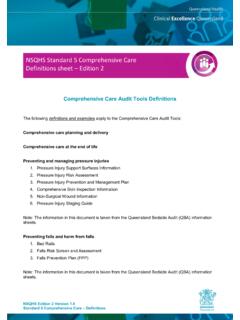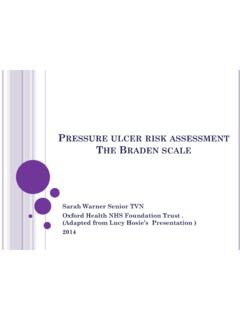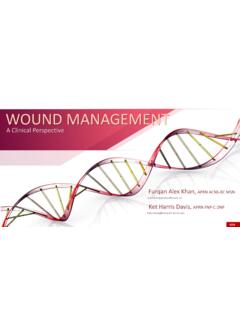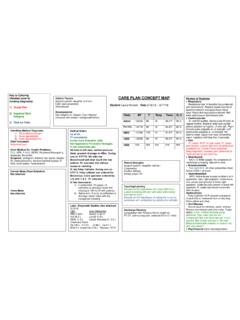Transcription of NUTRITION THERAPY FOR WOUNDS
1 NUTRITION THERAPY FOR WOUNDSC hristina Sherry, PhD, RD, MBAD isclosure The content of this program has met the continuing education criteria of being evidence-based, fair and balanced, and non-promotional. This educational event is supported by Abbott NUTRITION Health Institute, Abbott NUTRITION . Dr. Sherry is an Employee of Abbott NutritionLearning Objectives Describe the process of wound healing requirements for macro-and micronutrients Review the NUTRITION care process for individuals at risk and experiencing wound healing Learn NUTRITION interventions to augment wound healingIntroductionThis presentation reviews complexities associated with wound care and best practices to eliminate and overcome barriers of effective care through NUTRITION .
2 The process and progress of wound healing with NUTRITION as a vital component is addressed, including particular nutrient requirementsWound Incidence/PrevalenceAbout 2% of the adult population has a chronic wound. Chronic WOUNDS are considered: pressure ulcers/injuries lower extremity ulcers diabetic foot ulcers venous ulcers and arterial ulcers Prevalence is measured by the number of cases of pressure ulcers at a specific time. Incidence measures the number of new pressure ulcers without an ulcer at baselinePosthauer, & Marion, M.
3 (2017). In Mueller, (Ed.), The ASPEN Adult NUTRITION Core Curriculum.(3rded.). Silver Spring, MD: American Society for Parenteral and Enteral Process for WOUNDS in Normal StateInflammationInflammationProliferati onProliferationMaturationMaturationMidwo od KS et al. Int J Biochem Cell Biol. 2004;36(6):1031-1037; Chang HY et al. PLoS Biol. 2004;2(2):E7; Thompson C. Nutr Clin Pract. 2005;20(3):331-347; Posthauer, & Marion, M. (2017). In Mueller, (Ed.), The ASPEN Adult NUTRITION Core Curriculum.(3rded.). Silver Spring, MD: American Society for Parenteral and Enteral predictable, overlapping phasesNon-Healing, Chronic WoundsInflammationInflammationProliferat ionProliferationMaturationMaturationMidw ood KS et al.
4 Int J Biochem Cell Biol. 2004;36(6):1031-1037; Chang HY et al. PLoS Biol. 2004;2(2):E7; Thompson C. Nutr Clin Pract. 2005;20(3):331-347. WOUNDS get stuck in the inflammatory phaseAT RISK Patients: Common Factors Current or past medical condition(s)(eg, diabetes, renal disease, arterial disease) Immobility Incontinent Insufficient of sensory perception Compromised nutritional status(eg, malnutrition, dehydration, underweight, or overweightBraden Risk Assessment Scale. Accessed August 9, Systemic disease Perfusion/oxygenation Infection process NUTRITION /hydration AgeExtrinsic Mobility Wound bed environment Bacterial burden Soft tissue/bone infection Devitalized tissue MedicationsNutrition/hydration is seen as one of the most modifiable factors affecting wound healing Wound Healing ElementsMalnutrition is a Significant Contributor to Adverse Outcomes1.)
5 Schneider SM, et al. Br J ;92:105-111. 2. Merli M, et al. Clin Gastroenterol ;8:979-985. 3. Lee S, et al. Yonsei Med ;44 Fry D et al. Arch Surg. 2010;145:148-151; 5. Bauer JD et al. J Nutr Diet. 2007;20:558-564. 6. Kvamme JM, et al. Qual Life ; 7. Vivanti A, et al. J Nutr Health Aging. 2011;15:388-391; 8. Sungurtekin H, J Am Coll Nutr. 2004;23227-232; 9. Lim SL, et al. Clin Nutr. 2012;31(3) ulcers4 pressure ulcers4 Falls5 Falls5 Complications8 Complications8 Mobility7 Mobility7 Quality of life6 Quality of life6 Hospital length of stay9 Hospital length of stay9 Readmission9 Readmission9 Mortality9 Mortality9 Malnutrition Predicts Decubitus UlcersPreexisting ConditionOdds RatioDiabetic renal vascular D et al.
6 Arch Surg. 2010;145:148-151 Malnutrition was the 3rdpredictive factor for decubitus ulcers after major surgeryPrevalenceof MalnutritionzHOSPITAL ADMISSION33%of severely malnourishedpatients and 38% of well nourished patients experience nutritional decline4 Many patients continue to lose weight after discharge5 Patients with weight loss are at increased risk for readmission11. Tappenden KA et al. JPEN J Parenter Enteral ;37(4):482-497. 2. Naber TH et al. Am J Clin Nutr. 1997;66(5):1232-1239. 3. Somanchi M et al. JPEN J Parenter Enteral Nutr.
7 2011;35(2):209-216. C et al. J Am Diet Assoc. 2000;100(11):1316-1322. 5. Beattie AH et al. Gut. 2000;46(6):813-818. HOSPITAL STAY30% to 55% of hospital patients are malnourished upon admission1-4 HOSPITAL DISCHARGEHOSPITAL READMISSIONUse Multidisciplinary Team to Identify 6 Characteristics of MalnutritionWhite et al. ;112:730-738. 2. White et al. JPEN. 2012;36 of Muscle Mass & Function can Now Diagnose Malnutrition, Independent of Body Weight Insufficient Energy IntakeUnintentional Weight LossSubcutaneous Fat LossMuscle LossFluid AccumulationDeclining Functional StatusNUTRIENT NEEDSNPUAP Clinical Practice Guidelines:Evidence and Recommendations Haesler, E.
8 , Kottner, J. & Cuddigan, J. (2016). The 2014 International pressure Ulcer . Guideline: methods and development. Journal of advanced nursing, 73(6), 1515-1530. Strength of Evidence: B Strength of Recommendation:National pressure Ulcer Advisory Panel, European pressure Ulcer Advisory Panel, Pan Pacific pressure Injury Alliance. In: Haesler E, ed. Prevention and Treatment of pressure Ulcers: Quick Reference Guide. Osborne Park, Western Australia: Cambridge Media; Clinical Practice Guidelines for Energy Intake Offer fortified foods and/or high-calorie, high-protein oral nutritional supplements between meals if NUTRITION requirements cannot be achieved by dietary intake.
9 Goal for protein support for patients with pressure ulcers grams of protein per kilogram of body weight per day Strength of Evidence: B Strength of Recommendation: National pressure Ulcer Advisory Panel, European pressure Ulcer Advisory Panel, Pan Pacific pressure Injury Alliance. In: Haesler E, ed. Prevention and Treatment of pressure Ulcers: Quick Reference Guide. Osborne Park, Western Australia: Cambridge Media; Clinical Practice Guidelines for Protein Intake Supplement with high protein, arginine, and micronutrients for adults with a pressure ulcer category/stage 3 or 4 or multiple pressure ulcers when nutritional requirements cannot be met with traditional high-calorie and protein supplements.
10 CarbohydrateGlucose is the major fuel source for collagen synthesis and most efficient source of fuel compared with fat and protein. If insufficient CHO intake the body breaks down protein to provide glucose for cellular activity. Impaired utilization of CHO due to hyperglycemia leads to more proteolysis, glycogenolysis and lipolysis resulting in decreased wound healing Hyperglycemia also leads to osmotic diuresis and loss of water and electrolytes which negatively impacts wound healing by decreasing tissue oxygenation Both extracellular and intracellular dehydration occursProtein The use of negative pressure wound THERAPY increases protein losses of an estimated grams of protein per liter of fluid loss.




